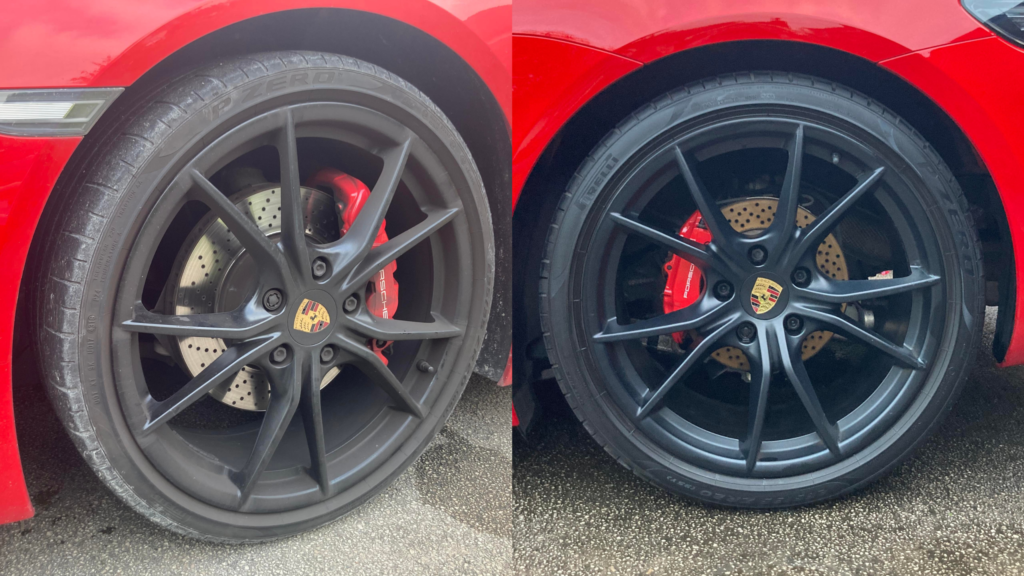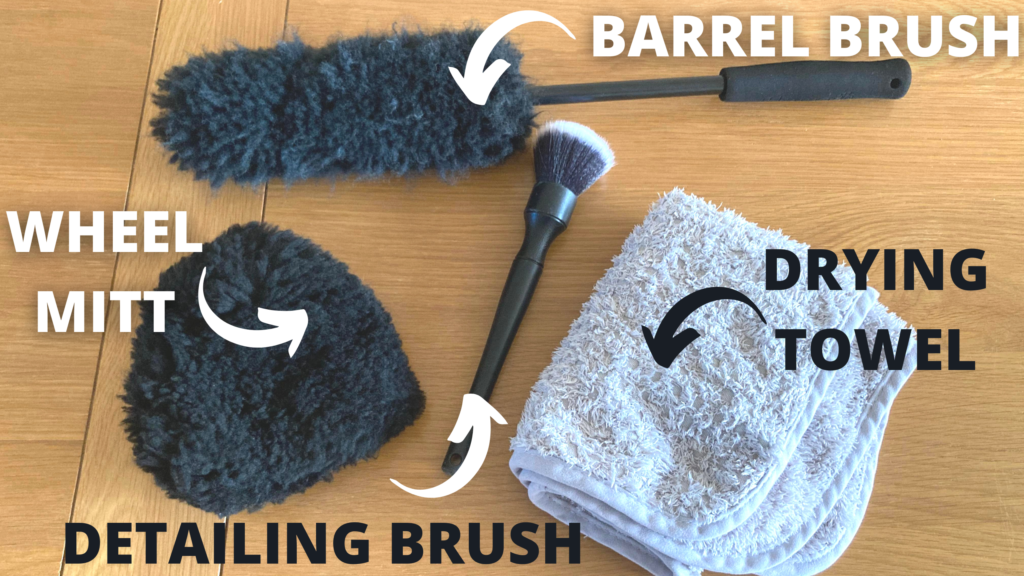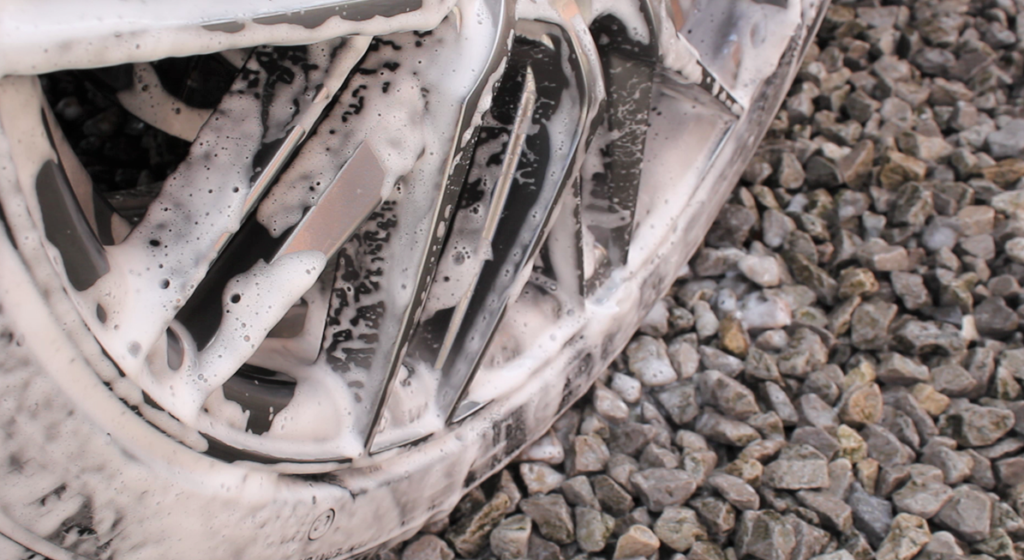Cleaning matte and satin alloy wheels is a simple and straight-forward process, there are just a few tips you need to follow to get the best results.
In this article I’ll explain how to properly clean and protect matte and satin finished wheels and all the equipment and products you’ll need.
Quick Guide to Cleaning Matte and Satin Wheels
To clean matte or satin wheels, use a dedicated pH neutral or mildly alkaline wheel cleaner or wheel shampoo without any waxes or gloss-enhancers. Use a microfiber or lambs’ wool wash mitt to agitate the wheel cleaner and rinse the solution away, ideally using a pressure washer.

Best Products to Use
To clean matte or satin wheels you’ll need the following:
- Pressure washer (or hose with nozzle attachment)
- Large bucket of water (10-15 L)
- An all-purpose cleaner or citrus pre-wash spray
- A pH neutral or mildly alkaline wheel shampoo/ cleaner
- Microfiber or wool wheel mitt
- Microfiber or wool wheel barrel brush
- Small soft detailing brush
- Microfiber towel
This page contains product affiliate links. We may receive a commission if you make a purchase after clicking on one of these links.
Pressure Washer and Bucket
Ideally, you should use a pressure washer with a fan attachment to clean the wheels as it is more effective and efficient at removing dirt in comparison to a garden hose. If you do not have access to a pressure washer, make sure you use a powerful nozzle attachment to create more pressure out of the hose.
The bucket of water will be used to rinse out your mitt/ brushes.
APC or Citrus Pre-Wash
I’d recommend using either an all-purpose cleaner (diluted to the recommended concentration) or a citrus pre-wash spray to clean the alloys before making any contact with them. This ensures as much dirt is removed as possible and not rubbed into the finish which can cause scratches.
Here are links to two of my favourites :
- Koch Chemie Greenstar (USA Amazon Link or UK Link) – diluted to 5% concentration (1 in 20)
- Mile Deep Release – diluted to 20% (1 in 5)
These products can also be used to clean the tires and wheel arches.
Wheel Cleaner or Shampoo
I’d advise using a wheel shampoo or sprayable wheel cleaner which does not contain any waxes or gloss-enhancers to clean matte or satin wheels. Regular car shampoos will also work but are not formulated to clean the wheels as thoroughly so I’d advise going with a dedicated wheel shampoo.
Here are links to my recommendations:
- Garage Therapy /ONE: Wheel Shampoo
- P&S Brake Buster (USA Amazon link or UK Link)
I’d advise against using any kind of acidic wheel cleaner or very strong alkaline wheel cleaner on matte or satin wheels as it can result in staining. Make sure you check on the bottle that the wheel cleaner you are using is safe for matte/ satin finishes.
Also never use any household products including dish soap to clean any part of the car.

Other Tools and Accessories
When cleaning the alloy wheels, I recommend using a mitt rather than a brush on the alloy face as it is less likely to cause scratches.
I have two favourite mitts which I switch between to do this, here are links to them:
You will also need a barrel brush to thoroughly clean the wheels. My personal favourite is the Mammoth Woolly Wheel Wand (Amazon link) as it is super soft and also compacts to fit into small gaps between the callipers and barrel.
A small detailing brush is also useful for cleaning intricate areas such as the lug nuts, brake callipers and tight corners on the alloy face where a wheel mitt cannot effectively reach. Make sure you use a very soft detailing brush such as the Detail Factory Brushes (Amazon link) to avoid causing scratches.
To dry the wheels you can use a soft, plush microfiber towel. A great option for this is The Rag Company Pluffle (Amazon link).

The Cleaning Process
Now that we’ve been through the equipment, let’s go through the cleaning process.
- Pre-wash the wheels
- Apply the wheel cleaner
- Agitate using the mitt and brushes
- Rinse and dry
Step 1: Pre-Wash
If you are using a pre-wash chemical such as the two mentioned in the previous section, apply this liberally to a dry wheel and allow to dwell for 2-3 minutes (but do not let the chemical dry out). Then, the wheel can be rinsed thoroughly using the pressure washer.
This process removes as much dirt and brake dust as possible before touching the alloy which helps to reduce the risk of scratches during the cleaning process.
If you are not using a pre-wash chemical, make sure you rinse the wheel thoroughly first before moving onto step 2.
Step 2: Apply the Wheel Cleaner
Next, you can apply your chosen wheel cleaner.
If you are using a sprayable wheel cleaner, simply apply this liberally and move onto step 3.
If you are using a wheel shampoo then you can use any one of the following methods:
- Add the wheel shampoo to your bucket of clean water and use it to lubricate the mitt and brushes you are using.
- Add the desired dilution to a foaming pump sprayer (usually approximately 10-20 mL per 500 mL of water) and spray all over the wheel.
- Mix it up in a spray bottle to the desired dilution (usually around 5-10%) and spray all over the wheels.
Personally I prefer to use method #2. This offers the most lubrication and best cleaning experience in my opinion. Here is a link to the IK Foamer I use on Amazon.
Step 3: Agitate
Next, you can use your mitts and brushes to agitate the cleaning solution and thoroughly wash the wheels.
I personally start with the alloy faces using the wheel mitt, then clean the lug nuts and brake calliper using the detailing brush and finally clean the wheel barrel using the barrel brush.
I periodically rinse each tool in the bucket of water to ensure that it does not become too contaminated with dirt and brake dust.

Step 4: Rinse and Dry
Once the wheel has been cleaned it can be rinsed with the pressure washer.
The wheels should be the first area of the car to be cleaned, so after this you should proceed to wash the rest of the vehicle.
Once the car has been washed and rinsed you can dry it using microfiber towels. Make sure you use separate towels for the wheels and paintwork to avoid cross-contamination.
How to Protect Matte Wheels
If you want to go a step further and protect your wheels you can use either a wheel wax/ sealant, spray and rinse sealant, or a wheel ceramic coating.
- Wheel waxes and sealants are not as durable but are easy to apply. E.g. Poorboy’s Wheel Sealant
- Ceramic coatings take the longest to apply but last for 1-2 years e.g. Gtechniq C5
I personally think a ceramic coating is the best option as it provides the best protection and lasts the longest. It also makes dirt less likely to stick the wheel and makes cleaning easier.
Check out this video on my YouTube channel showing how I applied a ceramic coating to my wheels.
Links to Protection Products Suitable for Matte and Satin Wheels:
Ceramic Coatings:
How Often Should the Wheels be Cleaned?
Ideally, matte and satin wheels should be cleaned at least every 2 weeks on a frequently driven vehicle. The minimum frequency I’d recommend to clean the wheels is monthly.
Cleaning the wheels more often makes the process easier and more effective. It also prevents the risk of corrosion since brake dust is corrosive and should not be allowed to sit on the wheels for extended periods of time.
Do Not Clay or Polish Matte or Satin Wheels
Matte and satin wheels should never be clayed or polished as these processes can both permanently damage the finish.
Instead, if you need to deep clean the wheels you can instead use chemical decontamination products such as iron fallout removers and tar removers when necessary. These will help to reduce contamination build-up but without damaging the finish (when following the manufacturer’s instructions).
Links to Products Mentioned in this Article
- Koch Chemie Greenstar (USA Amazon Link or UK Link)
- Mile Deep Release
- P&S Brake Buster (USA Amazon link or UK Link)
- Garage Therapy /ONE: Wheel Shampoo
- IK Foamer (Amazon link)
- Garage Therapy Wheel Mitt
- Autobrite Woolly Wheel Mitt
- Mammoth Woolly Wheel Wand (Amazon link)
- Detail Factory Brushes (Amazon link)
- The Rag Company Pluffle (Amazon link).

